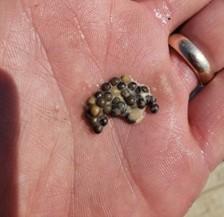U.S. EPA, together with the New York State Department of Environmental Conservation and Monroe County Department of Public Health, has removed the Loss of Fish and Wildlife Habitat Beneficial Use Impairment (BUI) from the Rochester Embayment Area of Concern (AOC). This BUI was removed on October 19, 2023. BUIs are designations listed in the 1987 amendment to the Great Lakes Water Quality Agreement that represent different types of significant environmental degradation (see Beneficial Use Impairments for the Great Lakes AOCs to learn more). The GLRI provided significant funding for the habitat restoration work required to remove this BUI.
Within Rochester Embayment AOC and the surrounding watershed, past industrial activity, commercial development, and altered shoreline and riparian habitat negatively impacted the area. Polluted waterways and extensive wetland loss impacted fish and wildlife through poor habitat conditions. Populations of key local species, such as lake sturgeon and mink, had been absent or in decline for decades due to the lack of suitable habitat needed for healthy reproduction, foraging, and other crucial life stages. Low diversity of amphibians and aquatic macroinvertebrates were some of the other indicators of poor habitat quality that led to the designation of the Loss of Fish and Wildlife Habitat BUI in this AOC.
To remove this BUI, state, federal, county/local, and non-profit partners focused on restoring and increasing wetland habitat in and adjacent to the Rochester Embayment. Partners identified eight key projects as part of the AOC Remedial Action Plan (RAP) to accomplish their restoration goals and satisfy the criteria for BUI removal. In completing these projects, partners increased the acreage of wetland habitat, improved existing wetland habitats, increased connections between river and wetland habitats, and ultimately created more suitable habitat to help fish and wildlife populations to recover. In addition to these eight projects completed under the RAP, supplemental habitat restoration projects and sediment remediation work conducted under other remedial programs have further improved conditions by creating additional wetland habitat and reducing sediment toxicity within the AOC.
Recent studies have shown that mink are present and reproducing in the AOC again, and lake sturgeon stocked in the lower Genesee River are beginning to reach maturity and were found spawning in the river for the first time in over 50 years. Additionally, assessments of the aquatic macroinvertebrate and amphibian communities in the embayment showed that species density and diversity is comparable to areas outside of the AOC. Collectively, the completed habitat restoration projects and the findings of the ecological assessments have satisfied restoration goals and supported the removal of the Loss of Fish and Wildlife Habitat BUI in the Rochester Embayment AOC. This is the final BUI removed from this AOC, signifying notable environmental improvements, and marking a crucial first step on the path forward to delisting.



